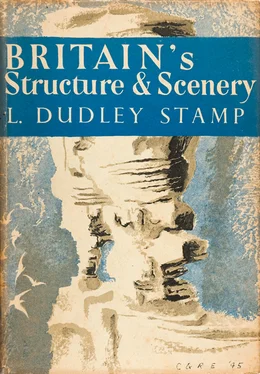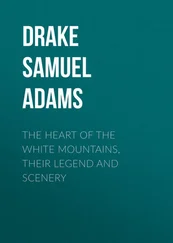Gradually, however, a river tends to reach a state of equilibrium and its longitudinal profile will form a smooth curve from source to mouth. When it reaches this stage a river is said to be graded and the land around has reached the stage of sub-aerial peneplanation. To achieve the graded curve, which will first be reached near the river’s mouth, the stream must necessarily cut back into the hills from which it takes its source and this involves headward erosion. It is found that
FIG. 17.—Diagrammatic Sections along a Talweg The upper diagram is a longitudinal section following the course of a relatively young river from its source to its mouth. Bands of hard rock cause waterfalls and rapids between which the river tends to assume a graded curve. Diagram II is the graded curve of a more mature river: the whole longitudinal section is evenly graded from source to mouth independently of any hard beds. Diagram III illustrates what happens if a fully graded mature river, such as that shown in II, is subjected to rejuvenation by a general uplift of the land surface relative to sea level. A knickpoint is formed independently of the character of the rocks and gradually works back, i.e. up the course of the river.
many mature rivers rise in a sort of amphitheatre, steep-sided but not nearly so steep-sided as the cirques from which glaciers have their origin.
Over the middle and lower courses of mature rivers, or rivers which have almost reached base-level, there are several characteristic features. The water swings from side to side and long winding meanders are the result (Fig. 12). Once a meander has been initiated there is a natural tendency for the swing of the water to make the curves ever more acute till at last the water breaks through the neck and the cut-off portion forms a stagnant “cut-off” or “ox-bow” lake. This will be clear from the diagram ; but what is not always realised is that the continuance of such a process results in a broad flat-floored valley with a deposit of gravel, sand, silt or alluvium. Such a flat floor is liable to flood when the river is in spate and so one gets a flood plain. Land liable to flood occurs along the lower courses of most British rivers. When the flooding is uncontrolled, a film of mud is spread by each flood and results in the gradual building up of alluvial flats. There is thus deposition closely associated with erosion in the middle and lower courses of a river. When the river reaches its mouth with a load of fine mud in suspension this may be swept seawards, especially if the sea into which the river discharges has a marked tidal movement. This is the case round the British Isles where nearly all our rivers enter into estuaries with a strong tidal movement. Where tides and currents are less strong the sediment is dropped near the mouth of the river and a delta of alluvium is gradually built up, passing seawards almost imperceptibly into very shallow muddy water. Since deltas are not typically formed round Britain it is unnecessary to enter into the details of their formation though there are many good examples where rivers enter lakes such as that shown in the foreground in Plate 31B. It is important to note the leading role played by vegetation in fixing the mud and then acting as a trap to catch more mud. In this way, though not directly associated with river mouths, there is accretion of land in such areas as around the Wash and in Morecambe Bay and advantage is taken of the natural processes in reclaiming land by building dykes or retaining walls to hold sediment. The stages in silting up are well shown in Plate XXV. Inland, artificially controlled flooding has long been practised, using the waters of such rivers as the Trent and Yorkshire Ouse to spread silt over the land after the manner of the Nile in Egypt and so both to build up the level and to spread a fertile layer rich in mineral salts and organic matter and of excellent mechanical texture. This controlled flooding is known as warping and the mud deposited as warp.
The well-graded meandering river with its broad valley floored with alluvium is a familiar feature in the British landscape. But even in geologically recent times, certainly since the Ice Age, there have been several changes in the relative level of land and sea, slight it may be but significant. What happens to such a mature river system when the land is lowered or raised relative to sea-level? First, if the land sinks, the lower valley is invaded by an arm of the sea and one gets the familiar feature of a drowned valley or ria. The best example of a coastline of drowned valleys or ria coast is the south-west of Ireland. Soundings show that the floor of the ria, the old river talweg, slopes steadily seawards and there is no “lip” as there is in the case of a glaciated valley with a rocky or morainic bar at the entrance (as in many of the Scottish fiords). Drowned valleys give rise to the picturesque winding creeks of south Devon and Cornwall—the estuary of the Fal and Tamar for example (Plate 26). It is clear that the branching tidal creeks shown in Plate 26 could not have been excavated by the action of the sea which now occupies them.
If, on the other hand, the level of the land is raised relative to the sea, the river undergoes rejuvenation; it is given new erosive powers and immediately begins lowering its bed. But such a rejuvenated river exhibits certain special features. It was, before the new uplift, a meandering mature river and the effect of the uplift is for it to follow its same meanders but to cut them deeply and so one gets the interesting and picturesque feature of incised meanders with a river winding in a gorge, it may be of considerable depth. If in such a case a meander is cut off one gets between the abandoned course and the new course a “meander core.” Incised meanders tend to develop where the rocks are relatively hard. Where a broad valley is excavated in relatively soft rocks the rejuvenated river develops for itself a new alluvial covered flood plain at a lower level than the old one and so fragments of the old one are left as gravel-covered or alluvium-covered terraces. Successive uplifts produce successive terraces at several levels. Those of the Findhorn in Scotland are well shown in Plate XXXI. The terraces of the Thames are not only well known but have been and are very important economically—for the dry sites they offer for settlement, for the water supplies once afforded by the gravels, for the excellent well-drained soils to which they give rise, for the brickearth they formerly supplied for brick making, and latterly for the supplies of gravel which, alas, is being excavated regardless of the future use of the devastated land. In the case of the Thames near London it is possible to distinguish one gravel-covered terrace at about 100 to 120 feet above present sea-level, though naturally varying in height with distance from the sea. This is the Boyn Hill Terrace and is very clearly marked in several areas. There is another terrace, of wide extent, at about 50 feet above sea level known as the Taplow or Middle Terrace. A third one is the Low or Flood Plain Terrace at some 10 or 15 feet above sea level. Then there followed a time when the Thames was lower than at present—or rather when the sea-level was lower and the river excavated what is now a buried channel so that to this extent the estuary of the Thames is a drowned valley. Actually the history of the Thames is much more complex than this, and such a complex history is typical of British rivers. Each change has some corresponding effect on tributaries. In the lower courses of a well graded river the effects of hard bands which may cross the valley have been eliminated and an interesting feature is found when the course of a rejuvenated river is followed upstream. There is found to be a point where there is a break in the longitudinal profile of the river. This is where it is still cutting back as a result of the change in level. Such a break of slope is known as a “knick point” and its development is to a large extent independent of any differences in the rocks of the river bed.
Читать дальше












